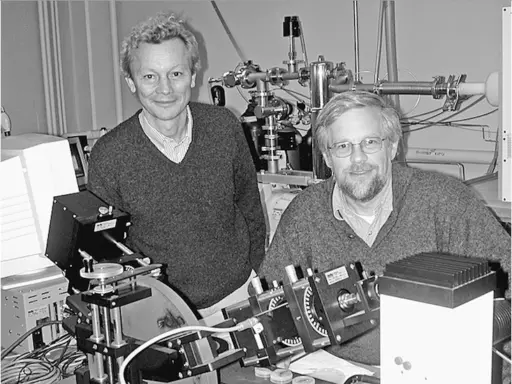Max Lagally, the Erwin W. Mueller Professor and Bascom Professor of Surface Science, is retiring after a long and distinguished career spanning almost five decades at UW-Madison.
But anyone who knows Lagally won’t be surprised to hear that he’ll barely be slowing down, even as a professor emeritus. His ongoing research collaborations keep Lagally busy—and he’s continuing to push the frontiers of our field forward.
 Max Lagally and Tom Keuch at work in the lab in 1985.
Max Lagally and Tom Keuch at work in the lab in 1985.
“Since I arrived, it’s been a goal of mine to contribute to making the department into a modern materials science department,” he says. “And it is now; we have very good people doing excellent work.”
Some of the people whom Lagally helped hire include Padma Gopalan, Chang-Beom Eom, Dane Morgan and Izabela Szlufarska. All came to the Department of Materials Science and Engineering under cluster hiring initiatives in which he was instrumental.
Lagally was one of the first professors in the department to take an atom-level view of materials science and engineering. He joined the faculty of the Engineering Experiment Station shortly after finishing his PhD in physics at UW-Madison in 1968 and completing postdoctoral work in Berlin, Germany. At the time, MS&E was still known as the Department of Mining and Metallurgy.
Since joining MS&E, Lagally has led the charge to bring in new technologies and fresh perspectives. Under his guidance, MS&E became a leader in the growth and characterization of thin films, and he was instrumental in building the university’s first scanning tunneling microscope.
Throughout his career, Lagally also focused on developing people; for example, he mentored numerous graduate students and postdoctoral scholars, many of whom went on to excel in industry or faculty positions at other institutions. He remains in touch with the majority of people who passed through his lab.
“One thing I’m particularly proud of is taking on students who struggled in other groups,” he says.
He knows the value of mentorship firsthand. During his early years as a professor, he often bounced ideas off engineering faculty including Roger Boom, Max Carbon, and Bob Marshall. Their encouragement spurred Lagally to explore new research areas, such as moving beyond metal characterization and into the then-new area of physical vapor deposition and thin-film growth.
Now, UW-Madison is a world-leader in materials synthesis, in part thanks to Lagally’s influence.
Characteristically modest, he never boasts about the professional recognition he’s received throughout his career (among his many honors, he is a fellow of both the American Association for the Advancement of Science and the National Academy of Engineering).
In fact, Lagally downplays his own brain power, noting, tongue-in-cheek, that his most-read publication likely is the Hoofers sailing manual, which he rewrote for the Hoofers Sailing Club back in the early 1970s and which still helps young Badgers learn how to tack and jibe.
And he also attributes the almost 20,000 citations his research papers have accumulated and the nearly 35 patents that sprang from his work to a simpler origin: “I’m too dumb to know what can’t be done. My collaborators and students and I are constantly creating new ideas,” he says.
And those new ideas keep coming. Lagally still participates in one of the two companies he co-founded—nPoint—while contributing to projects with faculty at UW-Madison, Boston University, University of Utah, University of New Mexico and the University of Hamburg, Germany.